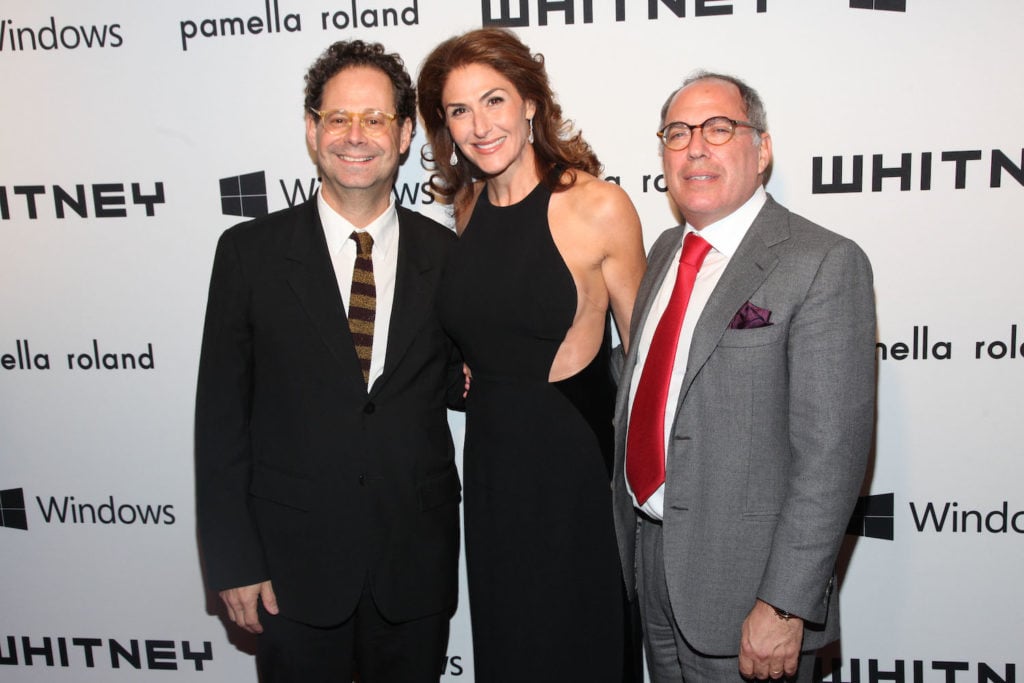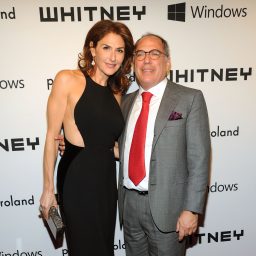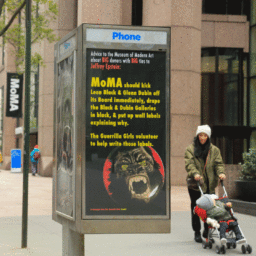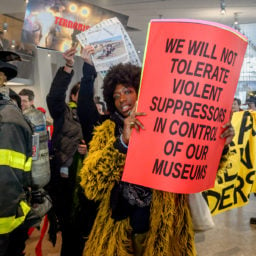Warren Kanders, the co-chair of the board of the Whitney Museum of American Art in New York, has stepped down following a sustained and escalating campaign of protest against the museum. The move comes just one week after a call to boycott the museum caused a wave of artists to pull out of the Whitney Biennial.
“The targeted campaign of attacks against me and my company that has been waged these past several months has threatened to undermine the important work of the Whitney,” Kanders wrote in his resignation letter to the board, which was first reported by the New York Times. “I joined this board to help the museum prosper. I do not wish to play a role, however inadvertent, in its demise.”
The Times writes that it is unclear to what degree Kanders was pressured by the Whitney leadership itself to step down. His resignation letter suggested that his presence had become controversial within the board. “I hope you assume the responsibility that your position bestows upon you and find the leadership to maintain the integrity of this museum,” he wrote to his colleagues.
Kanders joined the Whitney board in 2006 and has donated more than $10 million to the museum, according to the Times. His wife, Allison, who served as co-chairwoman of the museum’s painting and sculpture committee, resigned alongside her husband. Their names adorn a staircase at the museum’s Meatpacking District home. In a statement about Kanders’s departure that did not directly address the protests, the Whitney’s board expressed its “profound gratitude” to the couple for their “extraordinary generosity,” while the museum’s director Adam Weinberg acknowledged their “unwavering commitment” and lead gift toward the museum’s downtown home.
The campaign against Kanders began in November, after Hyperallergic reported that tear gas used by his company, Safariland, which produces munitions for police and military forces, had been fired at migrants on the US-Mexico border. The report added fuel to an already growing fire over “toxic philanthropy” in the museum sector that has put donors and board members under unprecedented scrutiny and led to the departure of the CEO of the Serpentine in London and a commitment from museums including Tate, the Guggenheim, and the Metropolitan Museum of Art, among others, to no longer accept money from members of the Sackler family who have been linked to the opioid crisis.
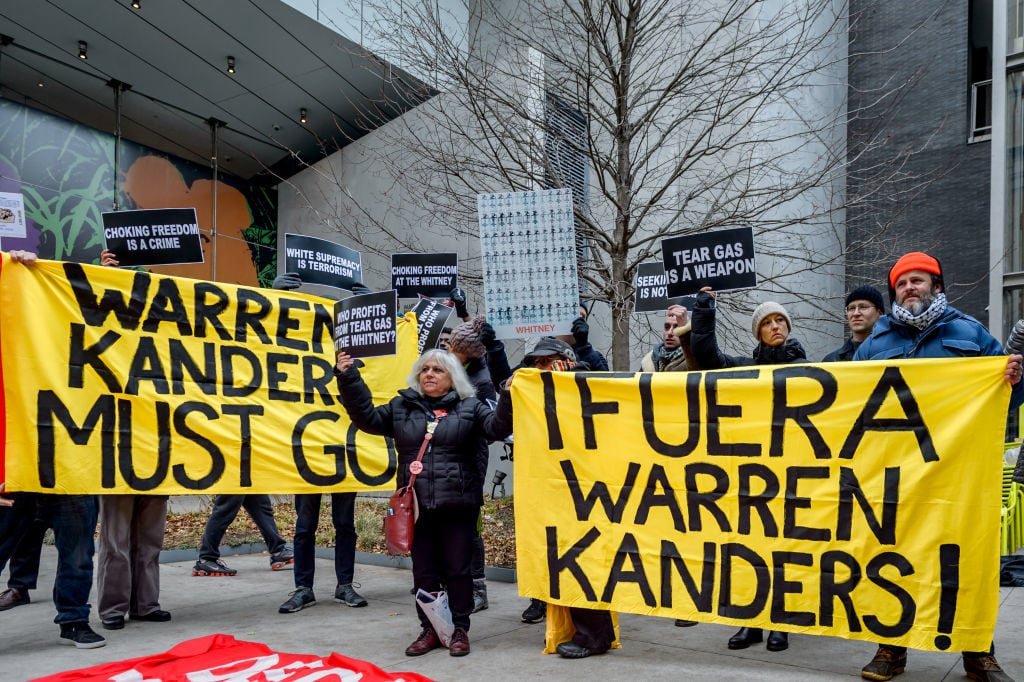
Activists protesting Warren Kanders at the Whitney Museum of American Art. Photo by Erik McGregor/Pacific Press/LightRocket via Getty Images.
Kanders and Philanthropy
Kanders, who started his career at Morgan Stanley, got his start buying up a series of eyewear stores before later investing in law enforcement and military products. He had previously resisted calls for his resignation. In response to a letter signed by nearly 100 Whitney staff members speaking out against Kanders at the end of November, the vice chair wrote: “I think it is clear I am not the problem the authors of the letter seek to solve.”
Over the years, Kanders and his foundation have donated lavishly to other cultural institutions, including the Aspen Art Museum, and educational institutions, including the Winston Churchill Foundation, Choate Rosemary Hall, and Brown University, where he sits on the advisory council for the school’s Institute for Environment and Society. Last November, the Warren and Allison Kanders lecture series at Brown sponsored the program “On Protest, Art, and Activism,” featuring socially engaged artists including Theaster Gates, the Guerrilla Girls, and Dread Scott, as well as Whitney curators Rujeko Hockley and Jennie Goldstein, both of whom went on to sign the staff letter denouncing Kanders.
(Earlier that year, in February 2018, a group of Brown alumni had written an op-ed in the university newspaper criticizing Kanders’s role on the board. He replied in a letter to the editor that he stood behind his business saying that it was “the first time I have been so directly attacked and insulted without the author[s]… reaching out for some comment.”)
In a testament to just how deeply elite philanthropists are embedded in the country’s cultural institutions, tax filings reveal that Kanders’s foundation also donated $5,000 to Artists Space in 2015, the year before Decolonize This Place, the group that led the protests against him at the Whitney, presented a two-month-long workshop there. Warren and Allison Kanders remain on the list of “Friends of Artists Space” to this day.
In his resignation letter, Kanders warned that such protests might end up dissuading donors from getting involved in cultural institutions. “The politicized and oftentimes toxic environment in which we find ourselves across all spheres of public discourse, including the art community, puts the work of this board in great jeopardy,” he wrote.
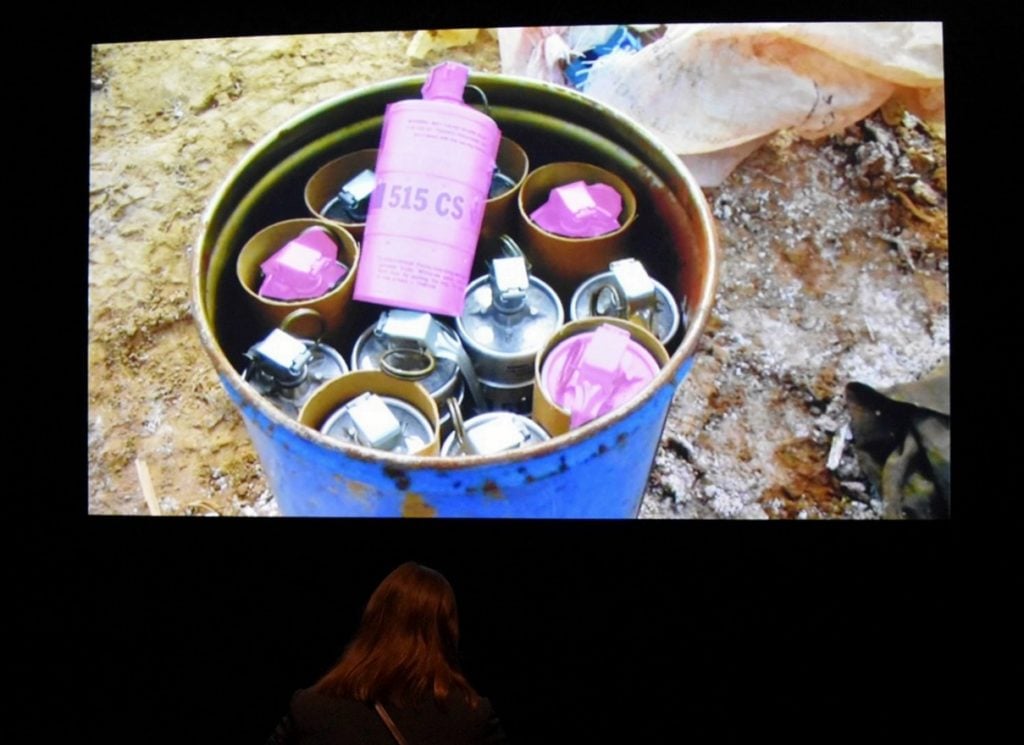
Installation view of Forensic Architecture, Triple-Chaser (2019). Image: Ben Davis.
Growing Protest
Protests at the Whitney began in December, when demonstrators occupied the museum lobby and burned white sage in protest of Kanders. In January, Decolonize This Place held a “town hall” meeting that drew hundreds of artists and supporters to Cooper Union, kicking off a nine-week campaign of Friday evening protests at the Whitney, culminating in May with a march from the museum to Kanders’s West Village home that drew several hundred people, chanting “Warren Kanders, you can’t hide!”
The Whitney Biennial, the museum’s signature event, was severely affected by the protests. In April, more than 100 scholars and critics signed a letter asking for the tear gas manufacturer to resign. This was followed by another open letter, signed by more than half of the artists in the show, asking for the same.
One artist, Michael Rakowitz, declined to participate from the start in solidarity with the campaign against Kanders, while an artist collective in the show, Forensic Architecture, made its contribution to the show a video documenting the use of tear gas and bullets linked to Kanders in state violence.
As the biennial kicked off, agitation continued both inside and outside the institution. Performer Morgan Bassichis dedicated part of his comedy set at the museum to amplifying the protests against Kanders. A protest group, (D)IRT, made an unauthorized guide to the show that was left in the galleries, mimicking the look of the Whitney’s official literature but laying out the case for Kanders’s removal from the museum board.
An early call for artists to boycott the event in solidarity with the protests against Kanders had fizzled. However, that campaign was suddenly revived last Thursday with the publication on Artforum.com of a forceful text, “The Tear Gas Biennial,” by Hannah Black, Tobi Haslett, and Ciarán Finlayson, calling on artists to pull out of the show.
The very next day, artists Korakrit Arunanondchai, Meriem Bennani, Nicholas Galanin, and Nicole Eisenman publicly asked to be removed from the show, protesting the Whitney’s failure to remove Kanders and saying they refused “further complicity with Kanders and his technologies of violence.” More followed over the weekend, touching off a new wave of press and scrutiny that made the Whitney protests mainstream news once more, preceding the public revelation of Kanders’s resignation on Thursday.
“We have heard that it would be impossible to remove Kanders,” Black, Haslett, and Finlayson wrote in Artforum.com, “everything is impossible before it happens.”
Read the full text of Kanders’s resignation letter below.
To the Board of Trustees of the Whitney Museum:
It is with great sadness and disappointment that I inform you of my decision to resign from the Board of Trustees of the Whitney Museum, effective immediately.
Unfortunately, the targeted campaign of attacks against me and my company that has been waged these past several months has threatened to undermine the important work of the Whitney. I joined this board to help the museum prosper. I do not wish to play a role, however inadvertent, in its demise.
Long before I found success in business, I had a love and appreciation for art. My wife, Allison, also shares this passion. The power of art lies in its ability to express, to push boundaries, and to ask questions. Art, as I know it, is not intended to force one-sided answers, or to suppress independent thinking. And yet, these recent events have illustrated how a single narrative, created and sustained by groups with a much larger and more insidious agenda, can overwhelm that spirit. The vibrant art community that this institution has been able to support since the days of Gertrude Vanderbilt Whitney is clearly at risk.
I remain grateful to Leonard Lauder for inviting me onto this Board in 2006, and for his steadfast support ever since. It has been my honor to serve alongside my many friends. I am proud of what we have accomplished, and for our service to the public and to our community. I believe the Whitney is in a better position today than it was when I began this work thirteen years ago. However, the politicized and oftentimes toxic environment in which we find ourselves across all spheres of public discourse, including the art community, puts the work of this Board in great jeopardy. I hope you assume the responsibility that your position bestows upon you and find the leadership to maintain the integrity of this museum.
Allison will also be resigning from her role as Co-Chair of the Painting and Sculpture Committee. Nonetheless, our support of the arts will continue, and we wish the Whitney and all our artist friends our very best.
